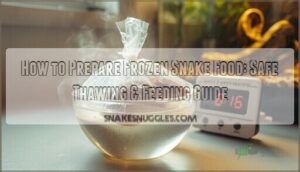This site is supported by our readers. We may earn a commission, at no cost to you, if you purchase through links.

Caring for pregnant snakes properly means learning to separate typical pregnancy behavior from genuine health problems, which requires understanding your species’ reproductive patterns and physical changes. Temperature fluctuations of just a few degrees can spell disaster for developing eggs or embryos, while improper substrate choices can lead to dystocia or fungal infections.
The difference between a successful clutch and a veterinary emergency often comes down to recognizing pre-lay restlessness, maintaining precise humidity levels, and knowing when decreased appetite signals trouble versus normal gravidity.
Table Of Contents
Key Takeaways
- Up to 90% of gravid ball pythons refuse food after ovulation as a normal response, making it crucial to distinguish typical pregnancy behavior from genuine health problems that require veterinary intervention.
- Temperature control between 80–85°F and humidity levels at 40–60% are critical for egg development, as fluctuations of just a few degrees can cause embryonic mortality or complications like dystocia.
- Snakes carry salmonella at rates of 63.1%, with 72% of reptile-associated strains showing antibiotic resistance, making proper hygiene and hand washing essential to protect children under five and immunocompromised family members.
- The pre-lay shed reliably signals egg-laying within 8–14 days for corn snakes and 18–28 days for pythons, giving you time to prepare proper nesting boxes with moist substrate and stable incubation conditions.
Key Differences in Snake Reproduction
Understanding how your snake reproduces is essential before you can provide proper care during pregnancy. Some species lay eggs while others give birth to live young, and each requires different preparation.
Let’s look at the key differences you need to know.
Egg-laying Vs. Live-bearing Species
Understanding reproductive methods helps you care for your pregnant snake properly. Egg-laying snakes like pythons, corn snakes, and king snakes are oviparous—they deposit eggs that develop outside the mother’s body during incubation. Viviparous snakes, including boa constrictors and garter snakes, give birth to live-bearing snakes after snake embryos develop internally.
This species comparison matters because each type needs different habitat preparations and monitoring approaches. Snakes that exhibit live birth traits require specific care to guarantee the health of both the mother and the offspring.
Common Pet Species and Their Habits
Each species has its own personality regarding pregnancy—some are steady and reliable, while others keep you guessing. Ball pythons often stop eating during breeding season, which is normal snake behavior for this species. Corn snakes and king snakes usually maintain steady appetites and predictable laying schedules.
Understanding these patterns helps you provide better pet snake care and avoid unnecessary worry. Your species selection matters—knowing whether you’re caring for a fussy ball python or a straightforward corn snake shapes your entire approach to habitat design and reptile nutrition during pregnancy.
Recognizing Pregnancy in Snakes
Once you know what to watch for, pregnancy signs become easier to spot. Abdominal swelling in the mid-to-hind section is the most visible change, especially in lean snakes. As eggs develop, you’ll notice a "lumpy pyramid" body shape rather than smooth weight gain.
Many livebearing snakes and egglaying snakes refuse food after ovulation—up to 90% of ball pythons stop eating during gravidity. Restlessness increases as laying approaches, and diagnostic methods like ultrasound can confirm pregnancy and count developing eggs safely.
Understanding snake egg incubation is vital for the health and safety of the pregnant snake.
Preparing a Safe Habitat for Pregnant Snakes
Your pregnant snake needs a calm, stable environment to support her through pregnancy and egg-laying. Getting the temperature, humidity, and enclosure setup right can make the difference between a successful birth and serious complications.
Let’s walk through what you need to create a safe space for her.
Temperature and Humidity Control
Your pregnant snake’s environment isn’t just a detail—it’s the difference between healthy hatchlings and heartbreaking losses.
Your pregnant snake’s environment determines whether you’ll celebrate healthy hatchlings or face heartbreaking losses
Maintain ambient control between 80–85°F during the day, dropping to 70–75°F at night. Humidity levels should stay within 40–60%—drop below or spike above 80%, and embryonic mortality climbs sharply.
Use reliable heat sources and monitor incubation temperatures daily for ideal snake health.
Privacy and Stress Reduction
Stress acts like a silent sabotage—it disrupts hormones, triggers egg retention, and can even cause your snake to abandon her clutch entirely.
Provide multiple hide boxes in a quiet environment with minimal foot traffic. Use visual barriers around snake enclosures to limit disturbances.
Watch for stress signals during the shedding process—excessive touching during snake pregnancy care can compromise snake health and derail successful reproduction.
Choosing Safe Substrates and Enclosures
The right substrate doesn’t just cushion eggs—it can mean the difference between healthy hatchlings and a failed clutch. Choose peat moss, sphagnum moss, or vermiculite for your incubation area—these retain moisture without becoming waterlogged.
For snake care during pregnancy, avoid cedar or pine shavings, which release toxic oils.
Your enclosure design should balance ventilation systems with humidity control, ensuring steady airflow without drying out the substrate during cage maintenance.
Nutrition and Health Management During Pregnancy
Pregnancy changes your snake’s nutritional needs and can bring health challenges you’ll want to watch for. Many gravid females eat less or stop eating entirely, which isn’t always a problem but sometimes signals illness.
Understanding what’s normal and what’s not will help you keep your pregnant snake healthy through this vulnerable time.
Adjusting Feeding Schedules
When your snake is carrying eggs or developing young, her appetite doesn’t follow the usual rulebook. Many gravid females eat less frequently—or stop altogether—as their bodies focus energy on reproduction rather than digestion.
You’ll want to reduce feeding frequency and offer smaller prey items, since pregnancy diet needs shift and digestion rates slow down. Monitor her closely; some loss of appetite is normal, but sudden changes may signal snake health concerns requiring veterinary attention.
Preventing and Identifying Anorexia
Anorexia isn’t always alarming—but knowing when it crosses from normal to concerning protects your snake’s reproductive health and overall well-being. During pregnancy, reduced appetite is expected, yet prolonged refusal (beyond two to three weeks) signals potential trouble requiring intervention.
Watch for these anorexia signs in gravid females:
- Visible body condition loss: ribs showing through skin, decreased muscle tone along the spine
- Behavioral changes: excessive hiding, striking defensively, or heightened stress responses during routine interactions
- Absent defecation: no waste production alongside persistent food refusal, especially in late pregnancy
Most gravid snakes resume eating rapidly after laying eggs or giving birth, distinguishing normal reproductive anorexia from pet snake health issues.
Feeding strategies like offering smaller prey, minimizing contact, and maintaining ideal temperatures support maternal care and snake nutrition throughout gestation.
Monitoring for Common Health Issues
Beyond appetite changes, subtle shifts in behavior or physical appearance often whisper warnings before serious complications arise during your snake’s pregnancy. Watch for respiratory issues like wheezing or mucus around nostrils, abnormal swellings suggesting infection or dystocia, and lethargy beyond normal gravid sluggishness.
Contact your veterinarian promptly if you notice prolonged snake anorexia paired with weight loss, visible lumps, or breathing difficulty—early intervention prevents life-threatening complications requiring immediate snake diseases and treatment through proper infection control and parasite management during this vulnerable period.
Safe Handling and Disease Prevention
Caring for a pregnant snake means protecting both your pet and your household from potential health risks. Snakes can carry bacteria that affect humans, and certain feeding practices introduce additional concerns during this sensitive time.
Let’s look at the key precautions that keep everyone safe.
Salmonella and Zoonotic Disease Risks
Your snake can carry salmonella even when it looks perfectly healthy. Snakes show the highest salmonella rates among reptiles at 63.1%, with captive animals reaching 68.1% colonization. Between 3% and 7% of human salmonellosis cases come from reptile contact.
Disease transmission happens through direct contact or touching contaminated enclosure surfaces. Public health concerns increase because 72% of reptile-associated salmonella strains resist multiple antibiotics.
Children under five face the greatest risk from zoonotic diseases from snakes, making infection control and reptile hygiene critical for safe reptile care.
Proper Hygiene and Protective Measures
Protecting yourself starts with washing your hands thoroughly with soap and water every time you touch your snake or clean its enclosure. Here are three essential hygiene practices for disease prevention:
- Wear protective gloves during cage cleaning and feeding to minimize direct contact with surfaces that may harbor bacteria.
- Designate snake-specific equipment that doesn’t enter your kitchen or living spaces to prevent cross-contamination.
- Disinfect surfaces with reptile-safe cleaners after every enclosure maintenance session to reduce disease transmission risks.
These simple protective measures greatly lower your family’s exposure to zoonotic disease.
Risks of Live Rodent Feeding
While hand washing protects you from bacterial infections, the choice between live and frozen-thawed rodents carries its own set of risks that many snake owners don’t fully appreciate.
Live mice can transmit parasites and diseases like leptospirosis—particularly concerning for pregnant women and immunocompromised individuals in your household.
Frozen-thawed ones eliminate most disease transmission risks while protecting both your pet snakes and family from rodent-borne infections during feeding.
Protecting Vulnerable Family Members
Infants, young children, and anyone with a weakened immune system need special protection when there’s a snake in the home. These vulnerable groups face higher risks from zoonotic diseases like salmonella, which can cause severe complications.
Keep your snake’s enclosure in a separate room away from areas where children play or sleep. Never allow direct contact between snakes and infants, and supervise older children carefully during any interactions to verify proper hygiene practices.
Best Practices for Breeding and Incubation
Successfully breeding and incubating snake eggs requires careful attention to timing and environmental conditions. Understanding the signs your snake is preparing to lay eggs helps you set up the right spaces at the right time.
The following practices will guide you through each stage of the breeding and incubation process.
Recognizing and Managing Pre-lay Shed
One of nature’s most reliable signals that eggs are on the way is the pre-lay shed—a complete skin change that happens like clockwork before your snake settles into her nesting spot. This shedding process marks the final stage of egg development, and timing varies by species:
- Corn snakes, milk snakes, and king snakes generally lay eggs 8-14 days after their pre-lay shed
- Pythons need more time—expect 18-28 days between the prelay shed and actual egg-laying
- Monitor behavior changes like reduced appetite and restlessness, signaling she’s preparing to nest
Recognizing these pre-lay signs helps you prepare proper nesting areas before she needs them.
Setting Up Laying and Incubation Areas
Your snake’s nesting box is like a delivery room—get it wrong, and you risk complications that could’ve been avoided with proper preparation. Start by placing a laying box filled with moist peat moss or sphagnum in her enclosure—dampened enough to hold shape without dripping.
Your incubator design should maintain steady temperature control at 80-85°F with humidity at 40-60%, ensuring proper snake incubation throughout development.
Egg Handling and Disinfection
Once your eggs are laid, how you manage them—and whether you clean them first—can mean the difference between healthy hatchlings and a clutch that never develops.
Manage snake egg care with soft gloves and cloth to prevent damage—don’t rotate them from their original position.
Disinfection methods involve gently wiping eggs with diluted antiseptic before incubation, reducing bacterial and fungal threats that increase failure rates during egg storage and hatch preparation.
Environmental Factors for Successful Hatching
With environmental temperatures between 78–82°F and humidity levels at 70–95%, you create the foundation for successful snake egg care and hatching eggs. Temperature control and humidity levels work together—incubation methods using vermiculite maintain stable conditions, while proper egg monitoring catches problems early.
Snake breeding tips emphasize daily checks with digital sensors placed at egg level, ensuring hatchling care begins with strong, healthy babies emerging after 50–70 days.
Frequently Asked Questions (FAQs)
What supplements help pregnant snake health?
Most healthy snakes don’t need supplements during pregnancy—think of it like how our grandmothers raised families without vitamin pills.
Focus on nutritional status through proper prey items instead.
Consult your veterinarian if you’re breeding snakes or concerned about calcium, protein, or mineral needs.
Can pregnant snakes be housed together safely?
Most pregnant snakes shouldn’t be housed together. Female aggression increases during pregnancy due to stress and territorial behavior.
Co-housing risks include fighting, injury, and pregnancy complications that compromise both snake health and reproductive success.
How often should gravid snakes be weighed?
Weigh your gravid snake weekly during pregnancy stages to track health and detect problems early. Consistent weight monitoring helps you spot sudden drops—often the first sign of complications—and guarantees proper nutrition throughout snake pregnancy.
Regular health checks support successful gravid care.
What signs indicate impending labor or laying?
Restless pacing, refusing food, and seeking secluded spots signal that laying or live birth is near.
For egg-laying species, watch for the pre-lay shed—this tells you eggs will arrive within days or weeks, depending on your snake.
Should lighting schedules change during snake pregnancy?
Does your snake’s internal clock need adjusting? Generally, you shouldn’t alter light cycles during pregnancy.
Maintain consistent photoperiod control—usually 12 hours on, 12 hours off—to support your snake’s circadian rhythms and reduce stress throughout breeding and gestation.
Conclusion
Think of it like tending a telegraph wire—one wrong signal, and the message never arrives. Caring for pregnant snakes properly demands vigilance: precise temperatures, reduced stress, and recognizing when appetite loss signals normalcy versus crisis.
Your attentiveness to pre-lay behavior, humidity levels, and substrate safety determines whether eggs develop successfully or complications arise.
When you spot restlessness or swelling, trust your preparation. These ancient creatures depend on your steady hand to guide them through their most vulnerable chapter.
- https://reptilesupershow.com/mastering-snake-breeding-tips-for-healthy-serpents/
- https://www.fhappliances.com/how-to-incubate-snake-eggs-a-complete-guide/
- https://pmc.ncbi.nlm.nih.gov/articles/PMC11978458/
- https://jewlscholar.mtsu.edu/bitstreams/c688c301-5e3b-41c6-84ee-0b87b73bf6de/download
- https://www.reptiles.swelluk.com/help-guides/snake-breeding-guide/












